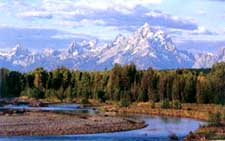Park Details
Maps!
 Go to Park Details
Go to Park DetailsThe rise of the Teton Range as well as the erosion caused by eons of glaciation have created the conditions that allow several plant communities to thrive, from ribbons of green riparian plants bordering rivers and streams, to sagebrush flats, lodgepole pine and spruce forests, subalpine meadows and alpine stone fields. The wide range of plant communities create habitat for a wide variety of animals, from the tiniest insects, to fish, birds and large and small mammals.
Humans have taken advantage of the mountain setting and its abundant resources for approximately 11,000 years. Early residents occupied the valley during the short spring, summer and fall seasons. During the other eight months of the year, they moved to lower elevations and warmer winter climates. Beginning in the late 1800's, homesteaders, ranchers and later dude ranchers moved into the valley, bringing the technologies of irrigation and insulation, to allow them to stay through the long, harsh winter.
With the establishment of Grand Teton National Park in 1929, and later additions in 1950, culminating in today's park, a wide variety of resources are protected for future generations. Enjoy the natural and cultural resources of the park in safe, resource compatible ways, through the entire year.
Park Details
Location Information
Location:
Northwestern Wyoming, south of Yellowstone National Park and north
of Jackson, Wyoming, in Teton County.
Address:
Grand Teton National Park
P.O. Drawer 170
Moose, WY 83012
Telephone:
(307) 739-3300
Transportation:
To Park: by car via I-70, I-80, I-25, I-15 and State 191; by tour bus on commercial tours
only (no public bus service is available to Jackson or Grand Teton); Commercial and
charter air service to Jackson Hole Airport with local taxi and rental car service from the
airport.
In Park: personal or rental vehicles, personal or rental bicycles, limited shuttle service with park concessioners, hiking.
Operating Hours/Seasons
The park is open from May through mid-October.
Reservations/Permits/Fees
Reservations and Permits:
Climate, Recommended Clothing
Long, cold winters. The first heavy snows fall by November 1 and continue through March with snow and frost possible during any month. Summer days in the 70's and 80's with cool nights in the 40's. Summer thunderstorms are common. Mild to cool temperatures through September and October. Raingear recommended during spring, summer and fall. Sub-zero temperatures are common throughout winter and demand multi-layered clothing, hats, mittens and cold weather boots.
Facilities and Opportunities
Visitor Centers:
Trails, Roads:
There are approximately 100 miles of park roads and 200 miles of trails throughout the park.
Most park trails are rough rock or dirt and are not accessible to visitors with disabilities.
There are many asphalt trails in the Jenny Lake area, some of which are accessible.
Some trails may begin as asphalt and deteriorate to dirt or gravel shortly thereafter.
Programs/Activities:
Summer walks, talks, and evening campfire programs. Inquire at park visitor centers and ranger
stations for schedules.
Lodging and camping facilities:
Lodging within the park is available through these park concessioners:
Flagg Ranch,
Box 187, Moran, WY 83013
Telephone: 1-800-443-2311
Grand Teton Lodge Co.
Box 240
Moran, WY 83013
Telephone: (307) 543-2811
Signal Mountain Lodge Co.
Box 50
Moran, WY 83013
Telephone: (307) 543-2831
Dornan's Spur Ranch Cabins
Box 39
Moose, WY 83012
Telephone: (307) 733-2415
Five National Park Service campgrounds are available within the park:
Food/supplies:
There are several restaurants inside the park that offer a variety of fare, from modest
buffet and counter service, to family dining to full service elegant dining. Restaurants are located
at the Jenny Lake Lodge, Signal Mountain Lodge, Jackson Lake Lodge and Flagg Ranch.
Buffet and snack bar service are available at Signal Mountain Lodge, Jackson Lake Lodge, Colter Bay and Flagg Ranch.
Dornan's offers either full meal service or, in the main season, a soup and sandwich delicatessen or outdoor barbecue.
Camper stores are available at Dornan's, South Jenny Lake, Signal Mountain, Colter Bay and Flagg Ranch. For major shopping, super markets are located in Jackson, as well as a full range of mountaineering, fishing, skiing, general hardware and auto parts stores.
Accessibility:
Facilities for visitors with disabilities include restrooms, picnic tables and a limited
number of campsites.
Recommended Activities/Park Use
Grand Teton National Park and the John D. Rockefeller, Jr., Memorial Parkway offer a variety of activities from traditional mountain park hiking, walking, wildlife viewing, photography, backpacking, camping, climbing and fishing to swimming, boating, floating, canoeing, biking and skiing, snowshoeing and snowmobiling in the winter.
Some activities such as overnight backpacking, boating, floating, canoeing, fishing and snowmobiling require fee permits, licenses or registration. Special regulations may also apply, so take the time to become informed at any visitor center or ranger station.
Check out additional suggested activities.
Visitation
3,100,000 per year, primarily between Memorial Day and September 30.
Basic Visit Recommendations:
An enjoyable visit to this heavily visited park requires some measure of planning and
timing. Some basic services such as rental cars, rental equipment and lodging are sold-out
every day. Reservations are essential for main season visits.
Campgrounds frequently fill by noon, with the possible exception of Gros Ventre Campground near the park's south boundary. Arrive early, plan carefully and seek information at park visitor centers and ranger stations.
Adjacent Visitor Attractions
Back to Park Details List
Top of Page
National Parks Home